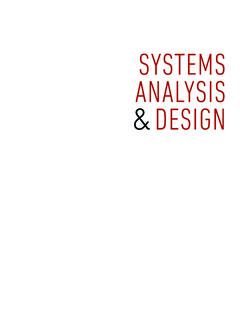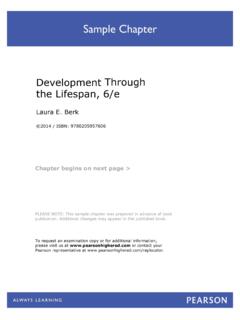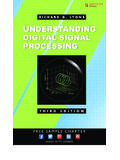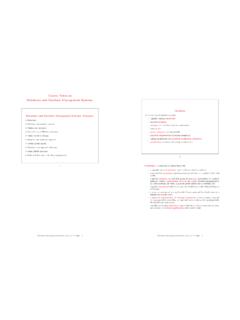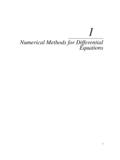Transcription of Discrete-Time Signals and Systems - Pearson
1 PreTeX, 14, 20098:102 discrete -TimeSignals and INTRODUCTIONThe termsignalis generally applied to something that conveys information. Signalsmay, for example, convey information about the state or behavior of a physical another class of examples, Signals are synthesized for the purpose of communicatinginformation between humans or between humans and machines. Although Signals canbe represented in many ways, in all cases, the information is contained in some patternof variations. Signals are represented mathematically as functions of one or more in-dependent variables. For example, a speech signal is represented mathematically as afunction of time , and a photographic image is represented as a brightness function oftwo spatial variables. A common convention and one that usually will be followed inthis book is to refer to the independent variable of the mathematical representationof a signal as time , although in specific examples, the independent variable may not infact correspond to independent variable in the mathematical representation of a signal may beeither continuous or signalsare defined along a continuum oftime and are thus represented by a continuous independent variable.
2 Continuous-timesignals are often referred to asanalog signalsare defined at discretetimes, and thus, the independent variable has discrete values; that is, Discrete-Time signalsare represented as sequences of numbers. Signals such as speech or images may haveeither a continuous- or a discrete -variable representation, and if certain conditions hold,these representations are entirely equivalent. Besides the independent variables beingeither continuous or discrete , the signal amplitude may be either continuous or signalsare those for which both time and amplitude are , 14, 20098:1010 Chapter 2 Discrete-Time Signals and SystemsSignal-processing Systems may be classified along the same lines as Signals . Thatis, continuous- time Systems are Systems for which both the input and the output arecontinuous- time Signals , and Discrete-Time Systems are those for which both the inputand the output are Discrete-Time Signals .
3 Similarly, a digital system is a system for whichboth the input and the output are digital Signals . Digital signal processing, then, dealswith the transformation of Signals that are discrete in both amplitude and time . Theprincipal focus of this book is on Discrete-Time rather than digital Signals and , the theory of Discrete-Time Signals and Systems is also exceedingly useful fordigital Signals and Systems , particularly if the signal amplitudes are finely quantized. Theeffects of signal amplitude quantization are considered in , , this chapter, we present the basic definitions, establish notation, and developand review the basic concepts associated with Discrete-Time Signals and Systems . The pre-sentation of this material assumes that the reader has had previous exposure to some ofthis material, perhaps with a different emphasis and notation. Thus, this chapter is pri-marily intended to provide a common foundation for material covered in later , we discuss the representation of Discrete-Time Signals as sequencesand describe the basic sequences such as the unit impulse, the unit step, and complexexponential, which play a central role in characterizing Discrete-Time Systems and formbuilding blocks for more general sequences.
4 In , the representation, basicproperties, and simple examples of Discrete-Time Systems are presented. on the important class of linear time -invariant (LTI) Systems and their time -domain representation through the convolution sum, with thespecific class of LTI Systems represented by linear, constant coefficient difference equa-tions. the frequency domain representation of Discrete-Time sys-tems through the concept of complex exponentials as eigenfunctions, and , , and explore the Fourier transform representation of discrete -timesignals as a linear combination of complex exponentials. a briefintroduction to Discrete-Time random Discrete-Time SIGNALSD iscrete- time Signals are represented mathematically as sequences of numbers. A se-quence of numbersx, in which thenthnumber in the sequence is denotedx[n],1isformally written asx={x[n]}, <n< ,( )wherenis an integer. In a practical setting, such sequences can often arise from periodicsampling of an analog ( , continuous- time ) signalxa(t).
5 In that case, the numeric valueof thenthnumber in the sequence is equal to the value of the analog signal ,xa(t),attimenT: ,x[n]=xa(nT ), <n< .( )The quantityTis thesampling period,and its reciprocal is thesampling frequency. Al-though sequences do not always arise from sampling analog waveforms, it is convenient1 Note that we use[]toenclose the independent variable of discrete -variable functions, and we use ( )to enclose the independent variable of continuous-variable , 14, 20098:10 Section Signals11to refer tox[n]as the nthsample of the sequence. Also, although, strictly speaking,x[n]denotes thenthnumber in the sequence, the notation of Eq. ( ) is often unnec-essarily cumbersome, and it is convenient and unambiguous to refer to the sequencex[n] when we mean the entire sequence, just as we referred to the analog signalxa(t). We depict Discrete-Time Signals ( , sequences) graphically, as shown in Al-though the abscissa is drawn as a continuous line, it is important to recognize thatx[n]is defined only for integer values ofn.
6 It is not correct to think ofx[n]as being zerowhennis not an integer;x[n]is simply undefined for noninteger values ofn. 9 7 5 3 4 6 8012345678 91011 1 2x[0]x[1]x[2]x[n]x[ 1]x[ 2]nFigure representation of adiscrete- time an example of a sequence obtained by sampling, (a) shows a segmentof a speech signal corresponding to acoustic pressure variation as a function of time ,and (b) presents a sequence of samples of the speech signal . Although theoriginal speech signal is defined at all values of timet, the sequence contains informationabout the signal only at discrete instants. The sampling theorem, discussed in Chapter4,32 ms(a)256 samples(b)Figure (a) Segment of a continuous- time speech signalxa(t ). (b) Sequence of samplesx[n]=xa(nT )obtained from the signal in part (a) withT=125 , 14, 20098:1012 Chapter 2 Discrete-Time Signals and Systemsguarantees that the original signal can be reconstructed as accurately as desired from acorresponding sequence of samples if the samples are taken frequently discussing the theory of Discrete-Time Signals and Systems , several basic se-quences are of particular importance.
7 These sequences are shown in willbe discussed sample sequence( ) is defined as the sequence [n]= 0,n =0,1,n=0.( )The unit sample sequence plays the same role for Discrete-Time Signals and Systems thatthe unit impulse function (Dirac delta function) does for continuous- time Signals andsystems. For convenience, we often refer to the unit sample sequence as a discrete -timeimpulse or simply as an impulse. It is important to note that a Discrete-Time impulsedoes not suffer from the mathematic complications of the continuous- time impulse; itsdefinition in Eq. ( ) is simple and sample0(a)n1 Unit step0(b)..nReal exponential0(c)nSinusoidal0(d)..nFigure basic sequences shown play importantroles in the analysis and representationof Discrete-Time Signals and , 14, 20098:10 Section Signals13103456872 2 4p[n]na 3a1a2a7 Figure of a sequence tobe represented as a sum of scaled,delayed of the important aspects of the impulse sequence is that an arbitrary sequencecan be represented as a sum of scaled, delayed impulses.
8 For example, the sequencep[n]in be expressed asp[n]=a 3 [n+3]+a1 [n 1]+a2 [n 2]+a7 [n 7].( )More generally, any sequence can be expressed asx[n]= k= x[k] [n k].( )We will make specific use of Eq. ( ) in discussing the representation of discrete -timelinear unit step sequence ( ) is defined asu[n]= 1,n 0,0,n<0.( )The unit step is related to the unit impulse byu[n]=n k= [k];( )that is, the value of the unit step sequence at ( time ) indexnis equal to the accumulatedsum of the value at indexnand all previous values of the impulse sequence. An alterna-tive representation of the unit step in terms of the impulse is obtained by interpretingthe unit step in (b) in terms of a sum of delayed impulses, as in Eq. ( ). Inthis case, the nonzero values are all unity, sou[n]= [n]+ [n 1]+ [n 2]+ ( )oru[n]= k=0 [n k].( )As yet another alternative, the impulse sequence can be expressed as the first backwarddifference of the unit step sequence, , [n]=u[n] u[n 1].
9 ( )Exponential sequences are another important class of basic Signals . The generalform of an exponential sequence isx[n]=A n.( )IfAand are real numbers, then the sequence is real. If 0< <1 andAis positive,then the sequence values are positive and decrease with increasingn, as in (c).PreTeX, 14, 20098:1014 Chapter 2 Discrete-Time Signals and SystemsFor 1< <0, the sequence values alternate in sign but again decrease in magnitudewith | |>1, then the sequence grows in magnitude exponential sequenceA nwith complex has real and imaginary parts thatare exponentially weighted sinusoids. Specifically, if =| |ej 0andA=|A|ej , thesequenceA ncan be expressed in any of the following ways:x[n]=A n=|A|ej | |nej 0n=|A|| |nej( 0n+ )( )=|A|| |ncos( 0n+ )+j|A|| |nsin( 0n+ ).The sequence oscillates with an exponentially growing envelope if| |>1 or with anexponentially decaying envelope if| |<1. (As a simple example, consider the case 0=.)
10 When| |=1, the sequence has the formx[n]=|A|ej( 0n+ )=|A|cos( 0n+ )+j|A|sin( 0n+ );( )that is, the real and imaginary parts ofej 0nvary sinusoidally withn. By analogy with thecontinuous- time case, the quantity 0is called thefrequencyof the complex sinusoidor complex exponential, and is called thephase. However, sincenis a dimensionlessinteger, the dimension of 0is radians. If we wish to maintain a closer analogy with thecontinuous- time case, we can specify the units of 0to be radians per sample and theunits ofnto be fact thatnis always an integer in Eq. ( ) leads to some important differ-ences between the properties of Discrete-Time and continuous- time complex exponentialsequences and sinusoidal sequences. Consider, for example, a frequency( 0+2 ).Inthis case,x[n]=Aej( 0+2 )n=Aej 0nej2 n=Aej 0n.( )Generally, complex exponential sequences with frequencies( 0+2 r), whererisan integer, are indistinguishable from one another.

